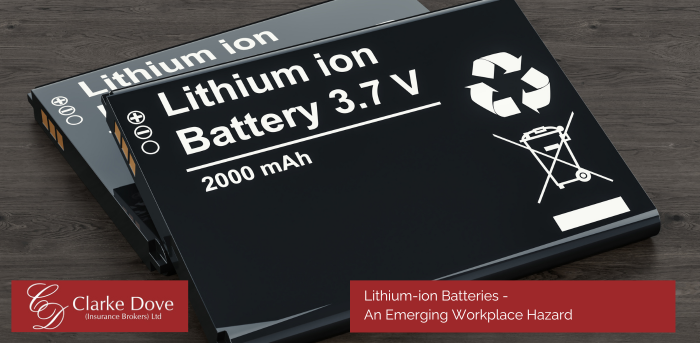Lithium-ion Battery Risks - An Emerging Workplace Hazard
Lithium-ion Battery Risks
June 2024
Lithium-ion Battery Risks - An Emerging Workplace Hazard
Lithium-ion batteries are powering more devices than ever at workplaces - from electric vehicles and forklifts to mobile phones and e-cigarettes. However, these batteries pose a severe and unique fire risk that businesses need to address proactively.
Unlike regular fires, lithium-ion battery fires cannot be extinguished with traditional methods.
They undergo thermal runaway, leading to explosions, shattering of the battery case, and release of toxic vapours like hydrogen fluoride. The fumes are hazardous and potentially fatal if inhaled.
Establishing proper safety protocols is critical for any workplace with lithium-ion batteries. Here we explore how you can protect your staff and business.
How can you reduce the risk of fire from Lithium-ion Batteries?
There are several steps you can take to reduce the risk, including:
-
Dedicated, restricted battery charging/storage areas with local exhaust ventilation.
-
Staff training on emergency evacuation and response procedures.
-
Prohibiting metal objects near batteries to prevent short-circuiting.
-
Never charging batteries unattended or under unstable conditions.
-
Proper disposal of swollen/damaged batteries through qualified companies.
-
Training on how to store and transport batteries safely.
fire spreads quickly and can potentially re-ignite days/weeks later.
Having a robust emergency plan and consulting insurance experts is vital to manage this emerging risk effectively.
What is thermal runaway?
Thermal runaway an irreversible and uncontrollable self-heating state a battery can enter, often when overcharged or damaged. In just seconds, this can lead to the breakout of a high-temperature fire, accompanied by smoke and vapours. An exploding battery can shatter fragments widely but also emit hazardous, toxic, and potentially fatal fumes. [1]
Why are Litium-ion batteries so dangerous?
Lithium-ion batteries now power many gadgets used in daily life. This includes e-bikes, around which videos circulate online, demonstrating their severe fire risk. Transfer the same logic to the world of work, and it is easy to see there are some workplaces in which the same severe risk exists.
Such batteries are found in motor trade repair shops that work on electric and hybrid cars; in other sectors, the power forklifts, power tools and various work vehicles.
Wherever they are present, the handling of lithium-ion batteries, their storage and the procedures to accompany any fire incident relating to them, need to be embedded in the business’s fire risk assessment and health and safety training programmes.
This is particularly true because a lithium-ion fire does not behave like a standard one. It cannot be tackled with traditional fire extinguishers, and nobody should attempt to extinguish one, unless they have undergone specific training. Failing to account for lithium-ion battery hazards can lead to catastrophic fires, injuries, and business disruptions.
With a lethal combination of substances, such as hydrogen fluoride, carbon monoxide, cobalt, nickel, copper and aluminium powder, the dangers to health include everything from death through inhalation, irreparable eye and skin damage, severe vomiting, ulceration of the mouth and throat, and organ damage.
Am I insured if a lithium-ion battery causes damage?
If lithium-ion batteries lead to a fire, then this would be the insured peril. Unless your specific policy has specific cover sections, endorsements, or restrictions then claims would be dealt with in the normal manner. If you are in any doubt, we would urge you to get in touch with us or your insurance broker.
Creating a safety plan around the use of such batteries is imperative. Identifying suitable local exhaust ventilation of a segregated battery charging area may be one action.
What we are seeing now is that insurers are now including specific provisions related to electric vehicles, such as coverage for the battery, charging points at home and public charging stations, as well as exclusions for misuse of charging cables, overcharging/undercharging, deliberate acts, self-repair/replacement, and damage to charging points.
These clauses aim to address the unique risks associated with electric vehicle ownership and charging and we expect to see these evolve over the coming months and years.
As your insurance broker we make sure to carefully review and explain these terms to you, to ensure you have the right protection in place.
Creating a safety plan around the use of such batteries is imperative. Identifying suitable local exhaust ventilation of a segregated battery charging area may be one action.
What Next?
Reach out to discuss managing this risk through policies, staff training, and adequate insurance coverage.
Source:
[1] QBE-Focus-CIRQ4-2023_online.pdf (cirmagazine.com)
[2] Willis Towers Watson Networks Spring 2024 Cover Notes
Synopsis - Lithium-ion batteries power many workplace devices but pose severe fire risks. Learn about the unique hazards of thermal runaway, explosions, and toxic fumes, and the critical safety protocols businesses must follow.

